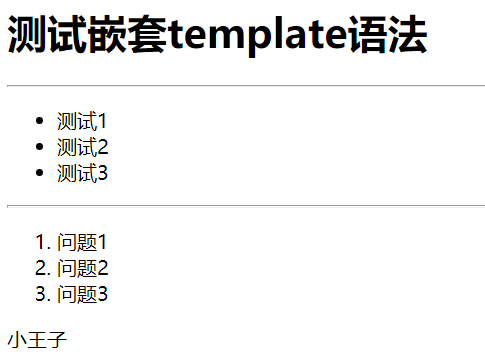嵌套模板
模板可以嵌套使用其他的模板,这个嵌套的模板可以是单独的文件,也可以是用define来定义的。
用define定义的模板语法:
{{ define "文件名"}}
内容
<!DOCTYPE html>
<html lang="zh-CN">
<head>
<meta charset="UTF-8">
<meta name="viewport" content="width=device-width, initial-scale=1.0">
<meta http-equiv="X-UA-Compatible" content="ie=edge">
<title>tmpl test</title>
</head>
<body>
<h1>测试嵌套template语法</h1>
<hr>
<!--单独的模板-->
{{template "ul.tmpl"}}
<hr>
<!--用define定义的模板-->
{{template "ol.tmpl"}}
<p>{{.Name}}</p>
</body>
</html>
{{ define "ol.tmpl"}}
<ol>
<li>问题1</li>
<li>问题2</li>
<li>问题3</li>
</ol>
{{end}}
ul.tmpl文件内容如下:
<ul>
<li>测试1</li>
<li>测试2</li>
<li>测试3</li>
</ul>
package main
import (
"fmt"
"net/http"
"text/template"
)
type User struct {
Name string //首字母大写,是对外暴露的,才能被调用,小写是不能被调用的
Gender string //
Age int
}
func nestTemplate(w http.ResponseWriter, r *http.Request) {
//解析模板 必须子模版在后面
tmpl, err := template.ParseFiles("./t.tmpl", "./ul.tmpl")
if err != nil {
fmt.Println("create template failed, err:", err)
return
}
user := User{
Name: "小王子",
Gender: "男",
Age: 18,
}
//执行模板
tmpl.Execute(w, user)
}
func main() {
//注册路由处理函数
http.HandleFunc("/hello", nestTemplate)
err := http.ListenAndServe(":9090", nil)
if err != nil {
fmt.Println("HTTP server failed,err:", err)
return
}
}
结果:

所有博客均为自己学习的笔记。如有错误敬请理解。




【推荐】国内首个AI IDE,深度理解中文开发场景,立即下载体验Trae
【推荐】编程新体验,更懂你的AI,立即体验豆包MarsCode编程助手
【推荐】抖音旗下AI助手豆包,你的智能百科全书,全免费不限次数
【推荐】轻量又高性能的 SSH 工具 IShell:AI 加持,快人一步
· 基于Microsoft.Extensions.AI核心库实现RAG应用
· Linux系列:如何用heaptrack跟踪.NET程序的非托管内存泄露
· 开发者必知的日志记录最佳实践
· SQL Server 2025 AI相关能力初探
· Linux系列:如何用 C#调用 C方法造成内存泄露
· 震惊!C++程序真的从main开始吗?99%的程序员都答错了
· 【硬核科普】Trae如何「偷看」你的代码?零基础破解AI编程运行原理
· 单元测试从入门到精通
· 上周热点回顾(3.3-3.9)
· winform 绘制太阳,地球,月球 运作规律